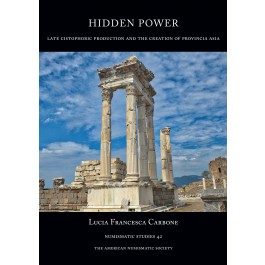Carbone, Lucia Hidden Power Late Cistophoric Production and the
Carbone, Lucia Hidden Power Late Cistophoric Production and the Organization of Provincia Asia (128–89 BC)
Edition 2020, 415 pages, size 21,5x258cm, Text english, Hardcover.
Using the production and circulation patterns of the Asian cistophorus as a case study, Hidden Power seeks to develop a better understanding of Roman monetary policy in the province of Asia between its establishment in the 120s BC and the beginning of the Mithraditic Wars.
Hidden Power catalogues and illustrates some 1,737 cistophoric tetradrachms and fractions from the mints of Ephesus, Pergamum, Tralles, Laodicea, Apamea, Adramyteum, Nysa, and Smyrna. Most of the coins included in the study are late cistophori, issues between 134.3 BC and the 60s BC.
Appendix I provides a discussion of the late cistophori of Tralles struck after 89 BC, showing not only the direct correlation between cistophori and Roman military campaigns, but also Roman taxation.
In Appendix II, circulation data have been combined with data derived from the Tralles die study in order to calculate cistophoric production für the entirety of provincia Asia until the end of the late cistophori. This estimate provides a means to assess the financial impact of Roman taxation and exploitation by Roman imperatores over the course of the first half of the first century BC.
Anhand der Produktions- und Zirkulationsmuster des asiatischen Cistophorus als Fallstudie versucht Hidden Power, ein besseres Verständnis der römischen Geldpolitik in der Provinz Asien zwischen ihrer Gründung in den 120er Jahren vor Christus und dem Beginn der mithraditischen Kriege zu entwickeln.
Hidden Power katalogisiert und illustriert etwa 1.737 cistophorische Tetradrachmen und Fraktionen aus den Münzstätten von Ephesus, Pergamon, Tralles, Laodizea, Apameia, Adramyteum, Nysa und Smyrna. Die meisten der in der Studie enthaltenen Münzen sind späte Cistophori, die zwischen 134,3 v. Chr. Und den 60er v. Chr. Ausgegeben wurden.
Anhang I ENTHÄLT eine Diskussion der späten Cistophori von Tralles nach 89 v. Chr., Die nicht nur den direkten Zusammenhang zwischen Cistophori und römischen Feldzügen, sondern auch die römische Besteuerung zeigt.
In Anhang II wurden Zirkulationsdaten mit Daten aus der Tralles-Die-Studie kombiniert, um die cistophorische Produktion für die gesamte Provinz Asien bis zum Ende der späten Cistophori zu berechnen. Diese Schätzung bietet ein Mittel zur Bewertung der finanziellen Auswirkungen der Besteuerung und Ausbeutung durch römische Imperatoren durch römische Imperatoren im Verlauf der ersten Hälfte des ersten Jahrhunderts vor Christus.
Quelle: Verlagsinfo

